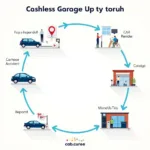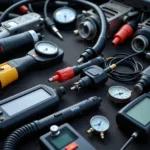Damage to the bottom of your car, often from road debris, potholes, or rust, can be a real headache. But is it possible to repair the bottom of a car? The short answer is yes, in most cases. This article will explore the various types of damage, repair options, and when it might be time to consider replacing parts instead of repairing them.
Repairing the undercarriage of a car is often more complex than fixing exterior damage. This is because the underside houses vital components like the exhaust system, fuel lines, brake lines, and the structural frame itself. A thorough inspection is crucial to determine the extent of the damage and the appropriate course of action.
Common Types of Undercarriage Damage
Several types of damage can occur to the bottom of a car. These include:
- Rust: Perhaps the most common culprit, rust can weaken the structural integrity of the undercarriage. Surface rust can often be treated, but severe rust might require part replacement.
- Dents and Punctures: Rocks, debris, and even potholes can cause dents and punctures in the undercarriage. Minor dents may not require immediate attention, but punctures can expose sensitive components to the elements and should be addressed promptly.
- Exhaust System Damage: The exhaust system is particularly vulnerable to damage from road debris. Leaks in the exhaust system can be dangerous and should be repaired immediately.
- Frame Damage: Frame damage is the most serious type of undercarriage damage and can compromise the safety of the vehicle. Repairing frame damage is complex and requires specialized equipment.
After a quick inspection at home, if you’re unsure about the severity of the damage, it’s always best to consult a qualified mechanic. They have the expertise to accurately assess the situation and recommend the best course of action. You might consider checking resources like how to repair car shocker for related suspension issues.
Repairing Undercarriage Damage: DIY vs. Professional
Minor damage, like surface rust or small dents, can sometimes be repaired at home with some basic tools and knowledge. However, more complex repairs, such as welding or frame straightening, require specialized equipment and expertise and should be left to professionals. Trying to fix these issues yourself could worsen the problem and even compromise your safety. Remember, you can find useful tips on other car repairs, such as how i repaired my car.
DIY Repairs: When and How
If you’re comfortable working on your car and the damage is minor, you can attempt some DIY repairs. For example, you can treat surface rust by sanding the affected area, applying a rust converter, and then repainting with a rust-resistant coating. However, be sure to follow safety precautions and use appropriate protective gear.
Professional Repairs: When to Seek Expert Help
For more significant damage, such as deep rust, punctures, exhaust system leaks, or frame damage, it’s essential to seek professional help. A qualified mechanic will have the tools, expertise, and experience to diagnose the problem accurately and perform the necessary repairs safely and effectively. They can also advise you on whether repairing or replacing a part is the most cost-effective solution. Sometimes, it’s better to replace the damaged part altogether, especially if the repair cost is close to the replacement cost. For instance, if you’ve been in an accident, check resources like can i repair my own car after an accident for professional advice.
Preventing Undercarriage Damage
Prevention is always better than cure. Here are a few tips to help protect the bottom of your car from damage:
- Regular Undercarriage Washes: Washing the undercarriage regularly, especially during winter, helps remove road salt and other corrosive materials that can cause rust.
- Rustproofing: Applying a rustproofing treatment can provide an additional layer of protection against corrosion.
- Careful Driving: Avoid driving over potholes and debris whenever possible.
- Regular Inspections: Regularly inspect the undercarriage for any signs of damage, such as rust, dents, or leaks.
“Regular inspections are key,” says automotive expert, Michael Stevens, ASE Certified Master Technician. “Catching undercarriage issues early can save you a lot of money and hassle in the long run.”
Conclusion
Is it possible to repair the bottom of a car? Absolutely. From minor rust patches to more serious frame damage, various repair options are available. By understanding the different types of damage, knowing when to DIY and when to seek professional help, and taking preventative measures, you can keep your car’s undercarriage in top condition and ensure its longevity and safety. Remember, regular maintenance and timely repairs are crucial for preserving your vehicle’s structural integrity and overall performance. If you have any doubts or concerns, always consult a qualified mechanic.
FAQ
- How much does it cost to repair the bottom of a car? (The cost varies greatly depending on the extent and type of damage.)
- Can I drive with a damaged undercarriage? (It depends on the severity; minor damage might be okay temporarily, but significant damage can be dangerous.)
- How often should I inspect the bottom of my car? (Ideally, every six months or with each oil change.)
- What are the signs of a damaged undercarriage? (Unusual noises, vibrations, visible rust or dents, fluid leaks.)
- Is it worth repairing a severely rusted undercarriage? (It depends on the extent of the rust and the overall condition of the vehicle. Sometimes replacement is more cost-effective.)
- What is the best way to prevent undercarriage rust? (Regular washing, rustproofing, and avoiding driving through standing water.)
- How long does it take to repair undercarriage damage? (The repair time depends on the type and severity of the damage.)
“Addressing undercarriage damage promptly is essential for maintaining the safety and value of your vehicle,” adds Sarah Johnson, Lead Mechanic at Johnson’s Auto Repair. “Don’t neglect the underside of your car – it plays a vital role in its overall performance and longevity.”
For any assistance, feel free to reach us on WhatsApp: +1(641)206-8880 or Email: [email protected]. Our customer support team is available 24/7.


